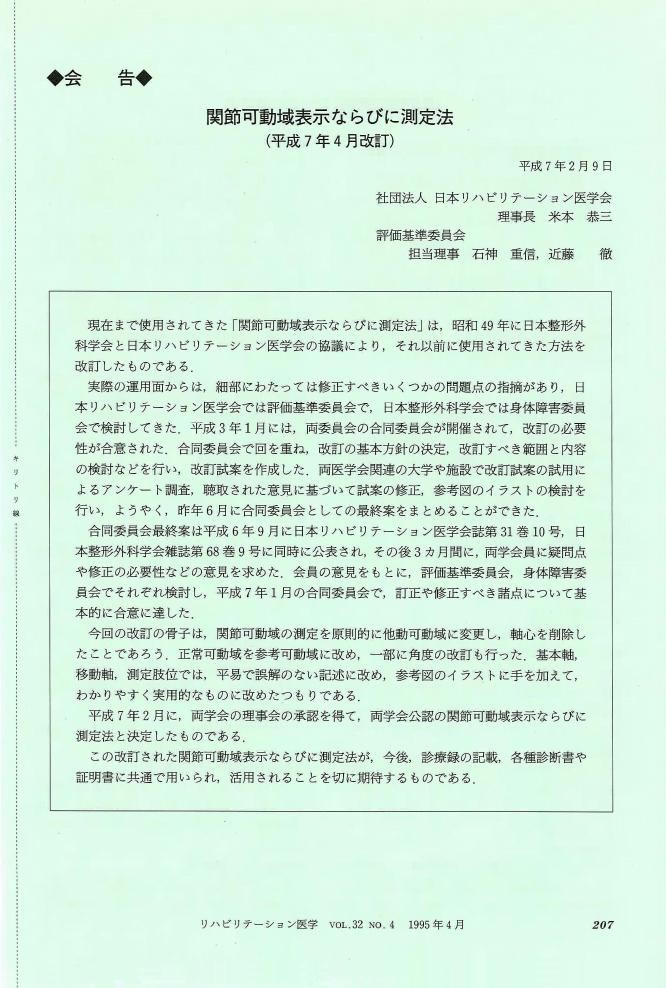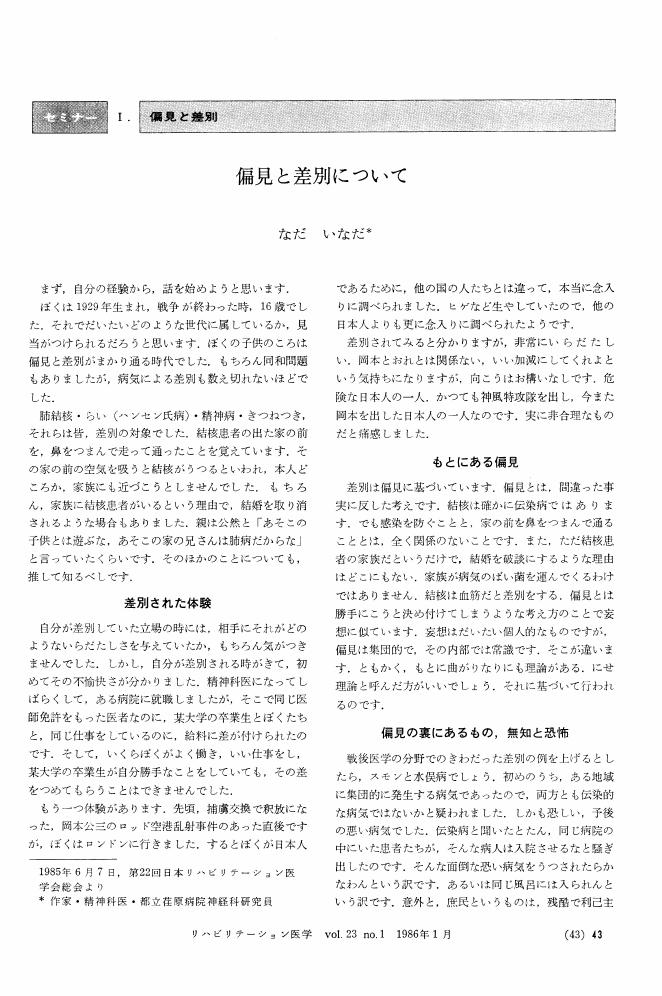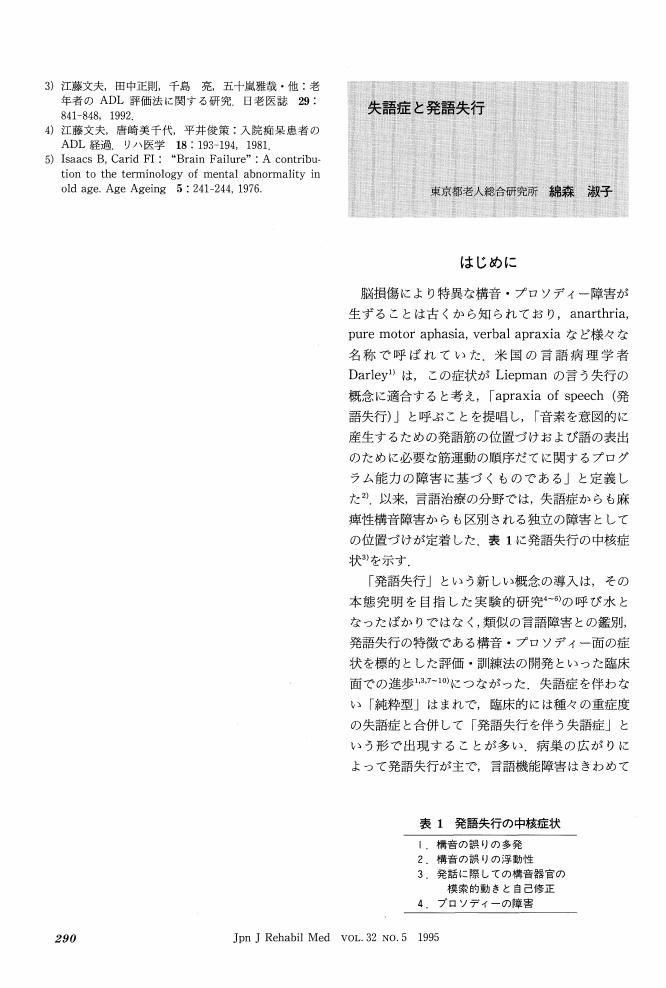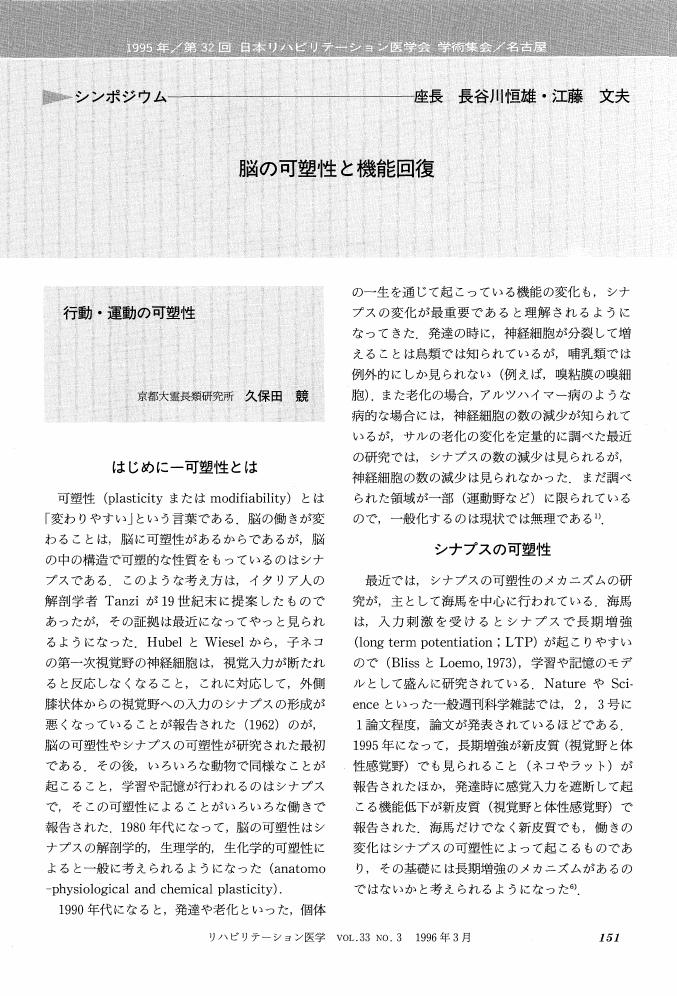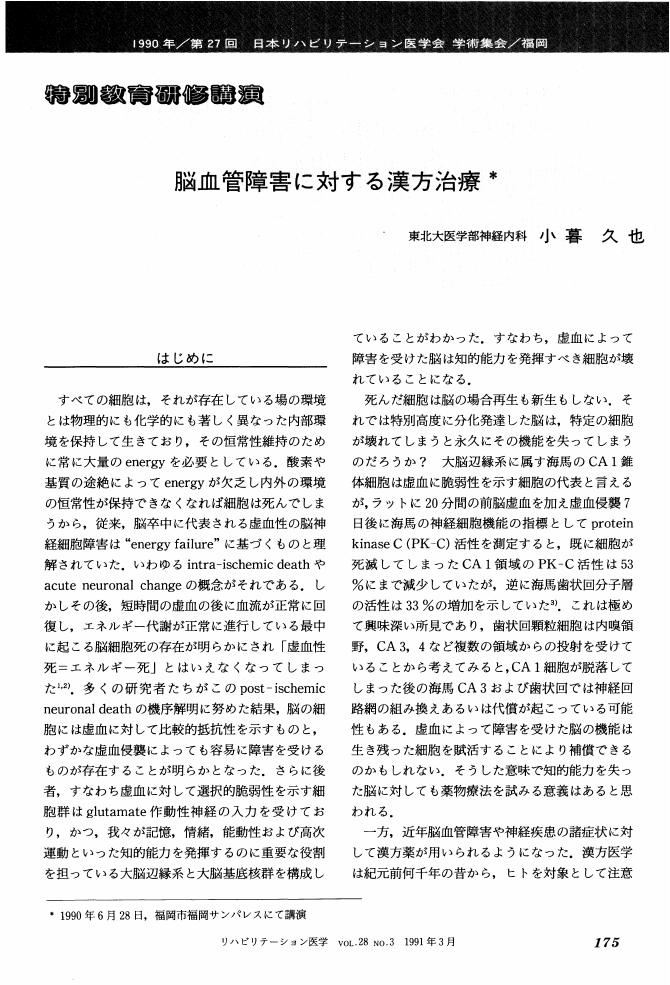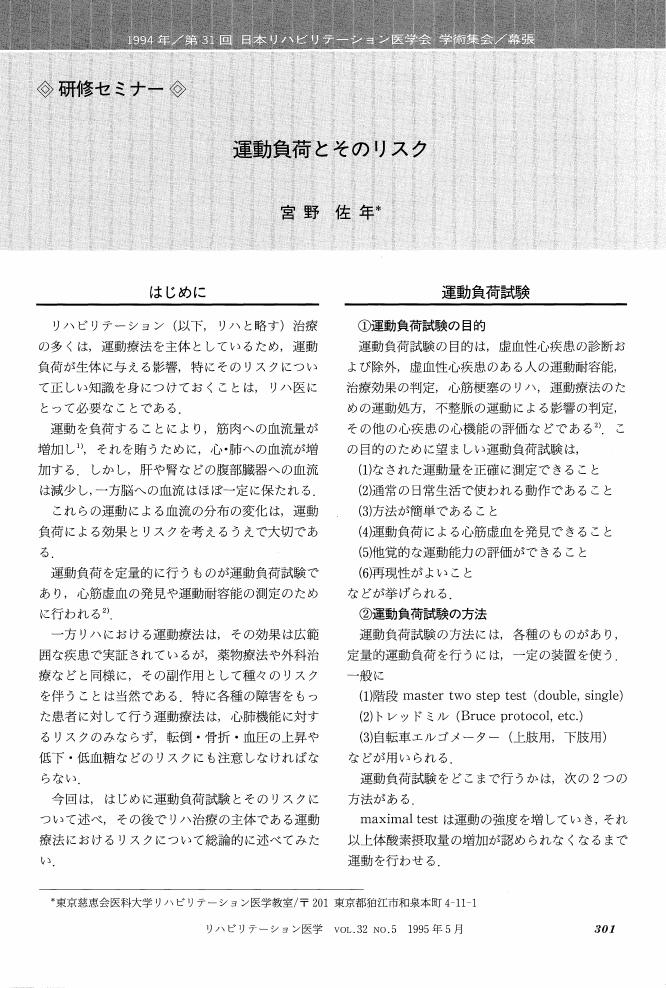39 0 0 0 OA 関節可動域表示ならびに測定法 (平成7年4月改訂)
- 著者
- 米本 恭三 石神 重信 近藤 徹
- 出版者
- 社団法人 日本リハビリテーション医学会
- 雑誌
- リハビリテーション医学 (ISSN:0034351X)
- 巻号頁・発行日
- vol.32, no.4, pp.207-217, 1995-04-18 (Released:2009-10-28)
- 被引用文献数
- 113 54
31 0 0 0 OA 偏見と差別について
- 著者
- なだ いなだ
- 出版者
- 社団法人 日本リハビリテーション医学会
- 雑誌
- リハビリテーション医学 (ISSN:0034351X)
- 巻号頁・発行日
- vol.23, no.1, pp.43-45, 1986-01-18 (Released:2009-10-28)
16 0 0 0 OA 宇宙飛行による骨·筋への影響と宇宙飛行士の運動プログラム
- 著者
- 大島 博 水野 康 川島 紫乃
- 出版者
- 社団法人 日本リハビリテーション医学会
- 雑誌
- リハビリテーション医学 (ISSN:0034351X)
- 巻号頁・発行日
- vol.43, no.3, pp.186-194, 2006 (Released:2006-05-01)
- 参考文献数
- 19
- 被引用文献数
- 2 1
Bone loss and muscle weakness are important medical concerns observed in astronauts after space flight. Even after a short-duration space flight, muscle atrophy and muscle weakness were observed in back, quadriceps and soleus-gastrocnemius muscles. The primary preventive measure against muscle weakness on the ISS has been exercise. The ISS houses a treadmill, a cycle ergometer, and a resistive exercise device. Individualized preflight exercise programs are planned for crew members based on fitness assessments, mission-specific tasks, and the maintenance of optimal health. A preflight exercise program is scheduled for a minimum of two hours a day, three days a week. Inflight exercise prescription will take into consideration available inflight exercise equipment and the specific needs of the individual crew member. Each inflight exercise program shall include components of cardiovascular, resistive and flexibility exercise. A program is scheduled for a minimum of 2.5 hours a day, six days a week. Postflight rehabilitation activities begin when a crew member returns from space flight. The goal of the rehabilitation program is to provide a planned program of recovery that will prevent additional injury, provide progressive improvement in fitness, and enable a full return to the preflight baseline level. A postflight rehabilitation program may include scheduled rest, assisted walking, swimming pool exercise and traditional exercise. Therapeutic massage, whirlpool, heat/ice and passive stretching also may be incorporated.
11 0 0 0 OA 失語症と発語失行
- 著者
- 綿森 淑子
- 出版者
- 社団法人 日本リハビリテーション医学会
- 雑誌
- リハビリテーション医学 (ISSN:0034351X)
- 巻号頁・発行日
- vol.32, no.5, pp.290-293, 1995-05-18 (Released:2009-10-28)
- 参考文献数
- 13
- 被引用文献数
- 2 2
7 0 0 0 OA 第32回日本リハビリテーション医学会学術集会
- 出版者
- 社団法人 日本リハビリテーション医学会
- 雑誌
- リハビリテーション医学 (ISSN:0034351X)
- 巻号頁・発行日
- vol.33, no.3, pp.151-166, 1996-03-18 (Released:2009-10-28)
6 0 0 0 OA 脳卒中リハビリテーション患者の早期自立度予測
- 著者
- 二木 立
- 出版者
- The Japanese Association of Rehabilitation Medicine
- 雑誌
- リハビリテーション医学 (ISSN:0034351X)
- 巻号頁・発行日
- vol.19, no.4, pp.201-223, 1982-07-18 (Released:2009-10-28)
- 参考文献数
- 53
- 被引用文献数
- 41 18
脳卒中患者のリハビリテーション後の最終自立度が,(1)患者の年齢,(2)各時期の自立度,(3)臨床的諸因子の組み合わせにより,早期にどの程度予測可能かを検討した.対象は発症後第30病日以内に入院した脳卒中患者406人で,平均年齢は67.0歳である.自立度は,屋外歩行,屋内歩行,ベッド上生活自立,全介助の4段階に分類し,臨床的諸因子としては,運動障害の他に,意識障害,痴呆,夜間せん妄等12因子を選んだ.これら諸因子を組み合わせて作製した予測基準により,入院時自立歩行不能患者のうち,7割は入院時に,8割は入院後2週時に,9割は同1月時に,最終自立度が予測可能であった.
6 0 0 0 OA 心筋梗塞患者の入浴
- 著者
- 井上 幸一 長谷川 武志 荏原 包臣 桑原 敏樹 藤田 良範 新谷 博一
- 出版者
- The Japanese Association of Rehabilitation Medicine
- 雑誌
- リハビリテーション医学 (ISSN:0034351X)
- 巻号頁・発行日
- vol.25, no.2, pp.93-104, 1988-03-18 (Released:2009-10-28)
- 参考文献数
- 20
- 被引用文献数
- 1
心筋梗塞回復期の男性患者54名に入浴の負荷試験を日常と同じ体を洗う動作を加えて行い,同時に40℃と42℃とを比較し,入浴の安全性と適温について検討した.PRP (pressure rate product)は温浴直後と洗う動作で増大し,心電図変化はST偏位が温浴と洗う動作で,期外収縮が温浴直後に多く出現し,1回心拍出量を表すPEP/ETは温浴で低下し,これらの変化は40℃より42℃で大きかった.臨床経過や検査成績を軽症と重症に分け比較すると,急性期Peelの予後指数10以上の例,リハの心合併症出現例,運動負荷試験の成績不良例,筆者らのHolter DCGの分類3以上の例など重症な例では,入浴時に心電図変化の出現が多く注意を要した.一方,軽症例では変化が少なく安全と考えられた.
6 0 0 0 OA 成人における下肢伸展挙上角度について
- 著者
- 忽那 龍雄 渡辺 英夫
- 出版者
- The Japanese Association of Rehabilitation Medicine
- 雑誌
- リハビリテーション医学 (ISSN:0034351X)
- 巻号頁・発行日
- vol.21, no.4, pp.215-219, 1984-07-18 (Released:2009-10-28)
- 参考文献数
- 6
- 被引用文献数
- 3 1
健康成人,男性946名,女性842名の両下肢の下肢伸展挙上角度(SLR角度)を調査し,SLRテストを評価する上に参考となる事項について述べた.即ち,1.日本人成人におけるSLR角度の正常値は,男性が右下肢78.7度±9.70度,左下肢79.0度±9.94度であり,女性が右下肢85.7度±8.48度,左下肢87.3度±8.38度であった.これらSLR角度の臨界値は男性65度,女性75度と考えられた.2.SLRテストを評価するにあたっては,正常者のSLR角度には男女差があり女性の角度が大きいこと,並びに左右差はなく左下肢と右下肢との間に高い相関があることに配慮する必要がある.3.また正常者におけるtight hamstringsの頻度は,男性が12.5%,女性が13.2%であった.
5 0 0 0 OA 脳血管障害に対する漢方治療
- 著者
- 小暮 久也
- 出版者
- 社団法人 日本リハビリテーション医学会
- 雑誌
- リハビリテーション医学 (ISSN:0034351X)
- 巻号頁・発行日
- vol.28, no.3, pp.175-180, 1991-03-18 (Released:2009-10-28)
- 参考文献数
- 20
5 0 0 0 OA 腰椎背筋群におけるコンパートメント症候群の病態と治療
- 著者
- 菊地 臣一
- 出版者
- 社団法人 日本リハビリテーション医学会
- 雑誌
- リハビリテーション医学 (ISSN:0034351X)
- 巻号頁・発行日
- vol.32, no.8, pp.531-541, 1995-08-18 (Released:2009-10-28)
- 参考文献数
- 25
- 被引用文献数
- 1
- 著者
- 辻 哲也 園田 茂 千野 直一
- 出版者
- 社団法人日本リハビリテーション医学会
- 雑誌
- リハビリテーション医学 (ISSN:0034351X)
- 巻号頁・発行日
- vol.33, no.5, pp.301-309, 1996-05-18
- 参考文献数
- 13
- 被引用文献数
- 26 51
機能的自立度評価法(FIM)を用いて, 脳血管障害患者190例の入院・退院時のADL評価を行った.項目別自立度により運動, 認知項目の難易度パターンを調べ, Rasch分析により運動, 認知項目の合計点別に各項目の点数分布を分析した.運動項目では, 難易度パターンは入院・退院時とも同様であり, 損傷病巣側, 年齢による差もなかった.認知項目では損傷病巣側により差がみられた.痴呆は難易度パターンに影響を与えていた.また, Rasch分析により, 運動項目は合計点別に50点未満の介助群から80点台後半の応用歩行自立群までの5つのグループに分けられた.一方, 認知項目では症例の一元性に問題があり, Rasch分析以外の解析手法を検討すべきであると思われた.
5 0 0 0 OA サウンドスペースプロセッサRSS-10によるヘッドフォン音方向覚検査の信頼性
- 著者
- 園田 茂 榊原 美紀 森 光代 山本 純子 岡島 康友 千野 直一
- 出版者
- 社団法人日本リハビリテーション医学会
- 雑誌
- リハビリテーション医学 : 日本リハビリテーション医学会誌 (ISSN:0034351X)
- 巻号頁・発行日
- vol.35, no.9, pp.641-644, 1998-09-18
- 被引用文献数
- 2
サウンドスペースプロセッサRSS-10を用いたヘッドフォン方式の音方向覚検査の信頼性を検討した. 15名の難聴でない健常被験者を対象に, ホワイトノイズ(WN)および女声(FV)を正面と, 左右に30度, 60度, 90度の計7点より3回ずつ呈示した. 音は全試行とも方向覚を持って聞こえ, 平均正答率62%, 呈示音と回答とのずれの角度は5〜18度, 平均12度(SD=9) (WN), 1〜19度, 平均11度(SD=8) (FV)であった. WNを左から右, 右から左に被験者の前を通るように約10秒で移動させ, 正中を通過したと感じられる時点の位置の平均はそれぞれ正面から-11.1度(SD=8.0), 3.4度(SD=7.5)であった. RSS-10を用いた音方向覚検査は再現性が高く, 臨床上有用と考えられた.
4 0 0 0 OA 脊髄損傷の性機能障害
- 著者
- 牛山 武久
- 出版者
- 社団法人 日本リハビリテーション医学会
- 雑誌
- リハビリテーション医学 (ISSN:0034351X)
- 巻号頁・発行日
- vol.41, no.10, pp.673-677, 2004-10-18 (Released:2009-10-28)
- 参考文献数
- 18
4 0 0 0 OA 運動負荷とそのリスク
- 著者
- 宮野 佐年
- 出版者
- 社団法人 日本リハビリテーション医学会
- 雑誌
- リハビリテーション医学 (ISSN:0034351X)
- 巻号頁・発行日
- vol.32, no.5, pp.301-306, 1995-05-18 (Released:2009-10-28)
- 参考文献数
- 14
- 被引用文献数
- 1 1
- 著者
- 小口 和代 才藤 栄一 水野 雅康 馬場 尊 奥井 美枝 鈴木 美保
- 出版者
- The Japanese Association of Rehabilitation Medicine
- 雑誌
- リハビリテーション医学 (ISSN:0034351X)
- 巻号頁・発行日
- vol.37, no.6, pp.375-382, 2000-06-18 (Released:2009-10-28)
- 参考文献数
- 19
- 被引用文献数
- 67 117
機能的嚥下障害スクリーニング法として,「反復唾液嚥下テスト」(the Repetitive Saliva Swallowing Test: RSST)を考案した.30秒間の平均空嚥下回数は若年者(N=30)で7.4回,高齢者(N=30)で5.9回,30秒間の平均人工唾液嚥下回数は若年者で7.7回,高齢者で6.2回であった.空嚥下,人工唾液嚥下ともに高齢者は若年者より有意に嚥下回数が少なかった.一方,若年者,高齢者それぞれの空嚥下と人工唾液嚥下の嚥下回数には有意差を認めなかった.嚥下運動の確認は喉頭挙上の触診で可能であった.高齢者の積算嚥下時間(検査開始から嚥下完了時点までの時間)上限より,RSST 2回/30秒間以下が嚥下障害のスクリーニング値として設定できた.
4 0 0 0 関節可動域表示ならびに測定法
- 著者
- 日本整形外科学会身体障害委員会 日本リハビリテーション医学会評価基準委員会
- 出版者
- 社団法人日本リハビリテーション医学会
- 雑誌
- リハビリテーション医学 : 日本リハビリテーション医学会誌 (ISSN:0034351X)
- 巻号頁・発行日
- vol.11, no.2, pp.127-132, 1974-06-18
- 被引用文献数
- 18 6
- 著者
- 小口 和代 才藤 栄一 馬場 尊 楠戸 正子 田中 ともみ 小野木 啓子
- 出版者
- 社団法人日本リハビリテーション医学会
- 雑誌
- リハビリテーション医学 : 日本リハビリテーション医学会誌 (ISSN:0034351X)
- 巻号頁・発行日
- vol.37, no.6, pp.383-388, 2000-06-18
- 参考文献数
- 10
- 被引用文献数
- 36
131名の機能的嚥下障害患者の「反復唾液嚥下テスト」(the Repetitive Saliva Swallowing Test: RSST)と嚥下ビデオレントゲン造影(videofluorography : VF)所見を比較し,RSSTの妥当性を検討した.RSSTはVF所見と相関が高く,カットオフ値として3回/30秒間が妥当であると思われた.誤嚥の有無の判別に関する感度と特異度は,0.98,0.66と,感度が非常に高かった.摂食・嚥下障害の診断・評価としては,まずRSSTでスクリーニングを行い,3回/30秒間未満の場合はさらに詳細な病歴,身体所見をとり,必要と判断されればVFを行い,治療方針を決定するのが適当である.
4 0 0 0 OA エビデンスからみた転倒予防プログラムの効果
- 著者
- 大高 洋平 里宇 明元 宇沢 充圭 千野 直一
- 出版者
- The Japanese Association of Rehabilitation Medicine
- 雑誌
- リハビリテーション医学 (ISSN:0034351X)
- 巻号頁・発行日
- vol.40, no.6, pp.374-388, 2003-06-18 (Released:2009-10-28)
- 参考文献数
- 72
- 被引用文献数
- 9 8
Fall prevention is one of the major issues in health care in our aging society. The aim of this review is to provide useful information for researchers and practitioners who plan to start fall prevention programs for elderly persons with various risk levels and in different settings. Fifty-three randomized controlled trials (RCTs) and several meta-analyses retrieved with extensive literature search formed the basis for this review. Available evidence suggests that several preventive strategies have been proven beneficial in fall prevention. For the community-dwelling elderly, two RCTs and one meta-analysis demonstrated that an individually tailored home exercise program provided by nurses or physical therapists could reduce the rate of falls and injuries. One RCT suggested that Tai Chi Chuan might have a high potential to reduce falls. Two large RCTs indicated that programs including group exercise classes could also reduce the number of fallers. For people with known risk factors living in the community, three RCTs showed that home visits to address multiple risk factor modification were an effective way to reduce falls. One RCT with a relatively small sample showed that psychotropic withdrawal reduced falls in elderly persons taking psychotropic medication. A subgroup analysis of one RCT showed that home hazard reduction at hospital discharge reduced subsequent falls in patients with a past history of falls. However, more evidence is needed to prove its effectiveness, because this effect was also observed outside of homes. Dual chamber pacemaker for elderly persons with hypersensitive carotid sinus, who were detected when investigated for undiagnosed falls, markedly reduced subsequent falls with or without syncope. In institutional settings, two RCTs showed that comprehensive risk assessment and modification reduced the rate of falls and fractures or the number of recurrent fallers. Three RCTs performed in hospital settings failed to show any effectiveness. However, a meta-analysis of 3 controlled trials and 7 cohort studies with a historical control suggested that fall prevention program in hospitals could be promising. There are some methodological problems in fall prevention research such as the definition, measures, and monitoring method of falls, inadequate sample size and a short follow-up period. In the future, we need research based on strong and comprehensive methodological designs.
4 0 0 0 OA エビデンスからみた転倒予防プログラムの効果 : 1. 狭義の転倒予防
- 著者
- 大高 洋平 里宇 明元 宇沢 充圭 千野 直一
- 出版者
- 社団法人日本リハビリテーション医学会
- 雑誌
- リハビリテーション医学 : 日本リハビリテーション医学会誌 (ISSN:0034351X)
- 巻号頁・発行日
- vol.40, no.6, pp.374-388, 2003-06-18
- 被引用文献数
- 11
Fall prevention is one of the major issues in health care in our aging society. The aim of this review is to provide useful information for researchers and practitioners who plan to start fall prevention programs for elderly persons with various risk levels and in different settings. Fifty-three randomized controlled trials (RCTs) and several metaanalyses retrieved with extensive literature search formed the basis for this review. Available evidence suggests that several preventive strategies have been proven beneficial in fall prevention. For the community-dwelling elderly, two RCTs and one meta-analysis demonstrated that an individually tailored home exercise program provided by nurses or physical therapists could reduce the rate of falls and injuries. One RCT suggested that Tai Chi Chuan might have a high potential to reduce falls. Two large RCTs indicated that programs including group exercise classes could also reduce the number of fallers. For people with known risk factors living in the community, three RCTs showed that home visits to address multiple risk factor modification were an effective way to reduce falls. One RCT with a relatively small sample showed that psychotropic withdrawal redeced falls in elderly persons taking psyshotropic medication. A subgroup analysis of one RCT showed that home hazard reduction at hospital discharge reduced subsequent falls in patients with a past history of falls. However, more evidence is needed to prove its effectiveness, because this effect was also observed outoside of homes. Dual chamber pacemaker for elderly persons with hypersensitive carotid sinus, who were detected when investigated for undiagnosed falls, markedly redeced subsequent falls with or without syncope. In institutional settings, two RCTs showed that comprehensive risk assessment and modification redeced the rate of falls and fractures or the number of recurrent fallers. Three RCTs performed in hospital settings failed to show any effectiveness. However, a meta-analysis of 3 controlled trials and 7 cohort studies with a historical control suggested that fall prevention program in hospitals could be promising. There are some methodological problems in fall prevention research such as the definition, measures, and monitoring method of falls, inadequate sample size and a short follow-up period. In the future, we need research based on strong and comprehensive methodological designs.
- 著者
- 大高 洋平 里宇 明元 宇沢 充圭 千野 直一
- 出版者
- 社団法人日本リハビリテーション医学会
- 雑誌
- リハビリテーション医学 : 日本リハビリテーション医学会誌 (ISSN:0034351X)
- 巻号頁・発行日
- vol.40, no.6, pp.389-397, 2003-06-18
- 被引用文献数
- 2
The cecond part of the review discusses some inportant issues associated with fall prevention and future perspectives on fall related research. Currently, many kinds of interventions ore availavle for the treatment of patients suffering from osteoporosis, i.e. nutritional supports, medications acting on bone metabolism and exercise. However, a series of meta-analyses showed that only alendronate and risedronate have been proven to prevent non-vertebral tractures in persons with osteoporosis. Anaerobic and weight bearing exercises are known to have a positive effect on the bone mineral density of the spine. There is, however, no reliable data for fracture prevention with exercise alone. Also, the synergistic effect of a combination of these interventions has noto been clearly proven. Although there is evidence that the use of hip protectors in institutional settings reduces the rate of hip fractures, this approach faces the problem of patient acceptance and compliance. Psychosocial problems related to falls such as fear of falling, post-fall syndrone and cost-effectiveness of the prevention programs are becoming increasingly important in elderly health care, but little evidence of such has been reported in the literature. In future perspectives on fall relared research, a theory-based approach for fall prevention needs to be included to explore more effective interventions. We must also consider the double-edged effects of interventions that may increase certain fall risk factors while reducing another. Especially, the relation between activities and incidence of falls is important to consider, because increased activity itself may increase the change of falls. When applying exercise or rehabilitative approaches, the interaction between falls, activity levels, frailty, and injury must be studied much more carefully. In addition, one has to always think about what is the true aim of a program, because the aim of fall prevention goes beyond preventing falls. Although some research has so far been conducted in Europe and the U.S.A. by researchers and practitioners in various fields, the quantity and quality of fall prevention research are still lacking and the available data is therefore insufficient to suggest appropriate decision-making in clinical practice. Especially in Japan, there have been only a few RCTs to determine the effectiveness of fall prevention programs. Because there are many differences in the characteristics of our native population and health care systems vs those of Europe and the U.S.A., it is a critical issue for us to establishi fall prevention programs suited to Japanese population and health care system.
